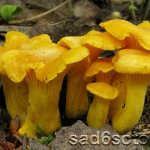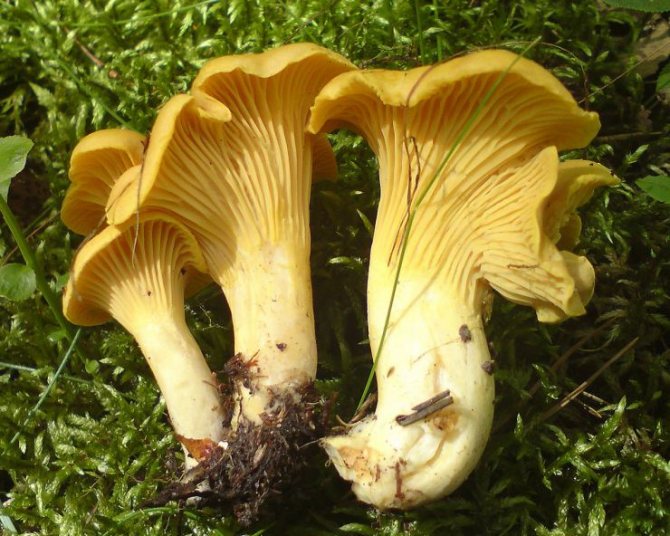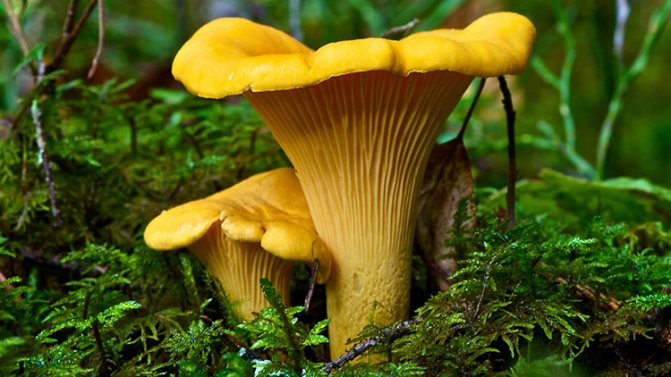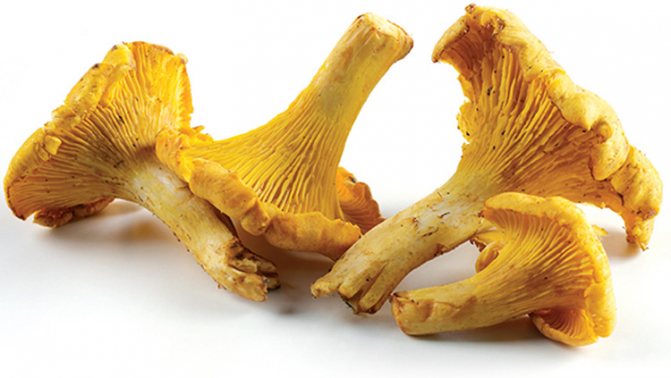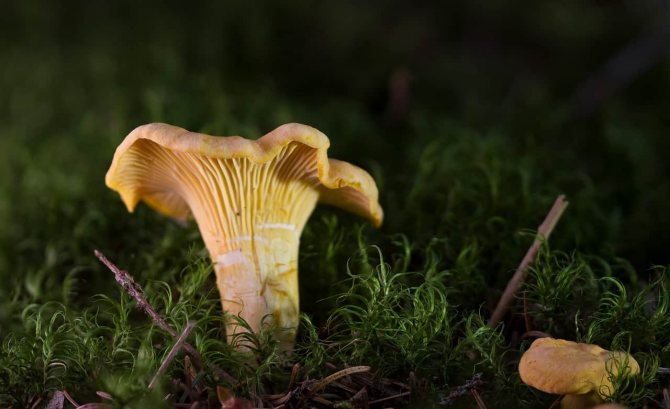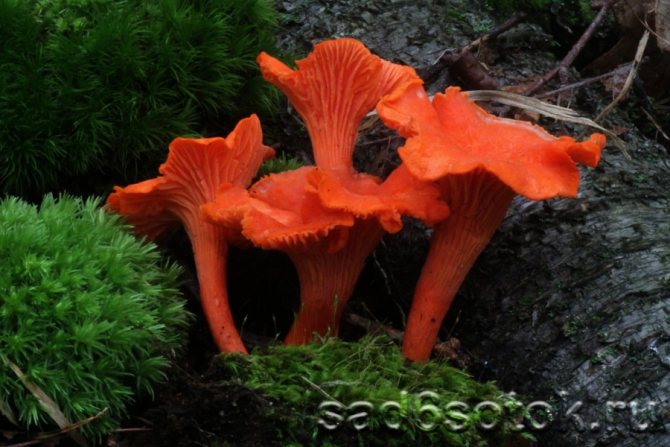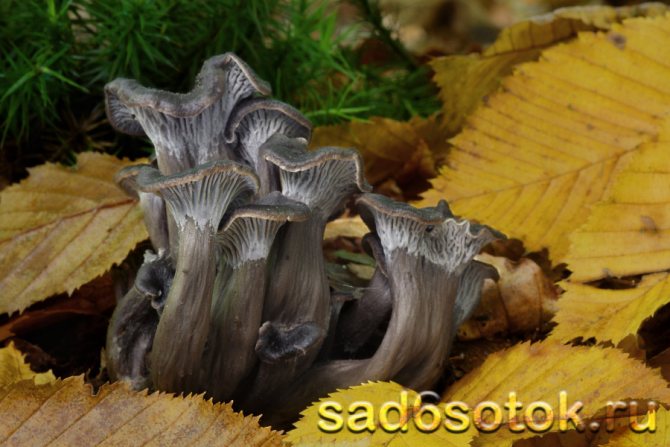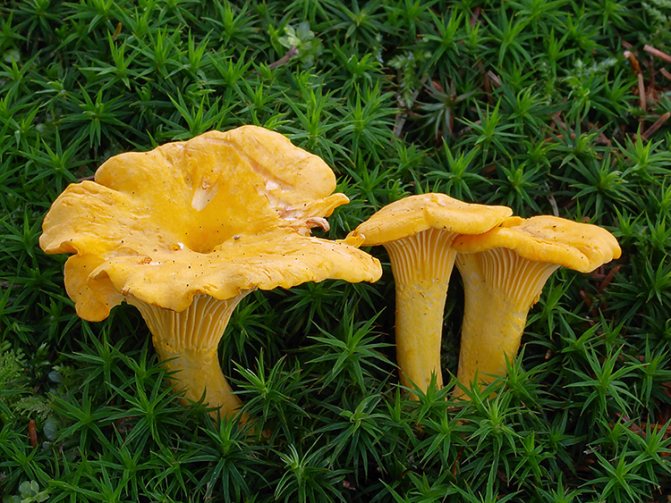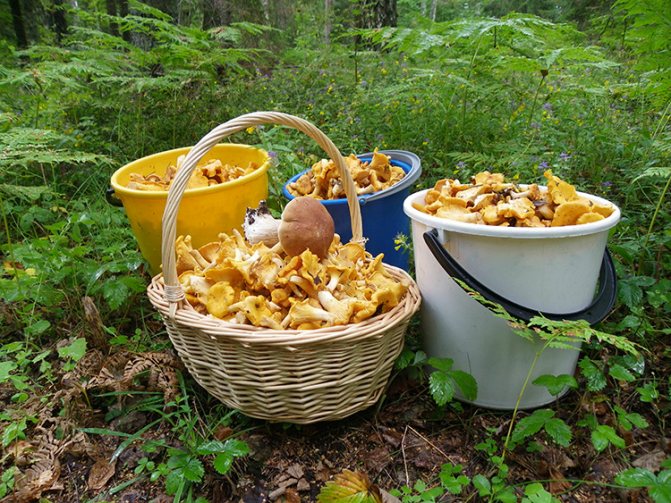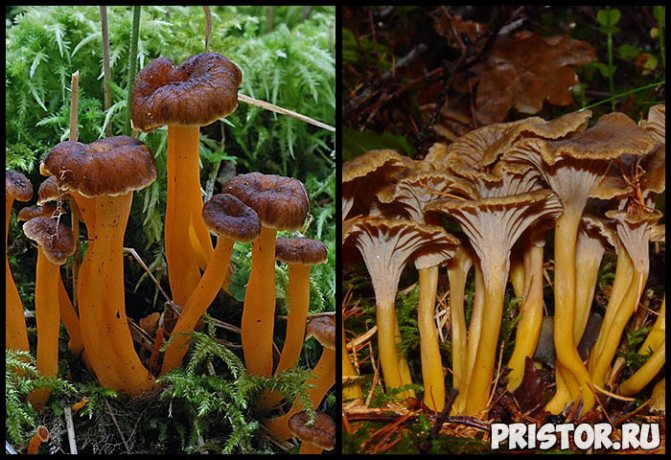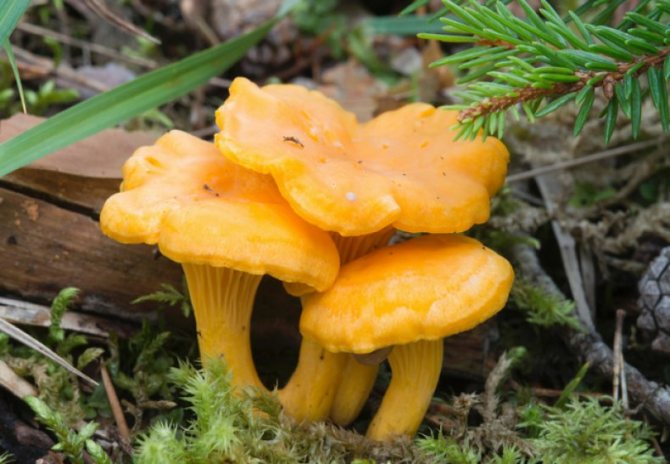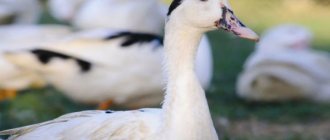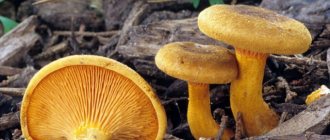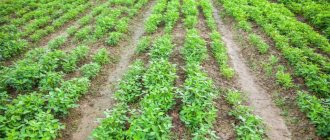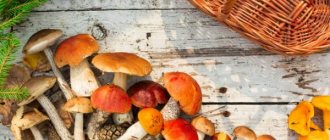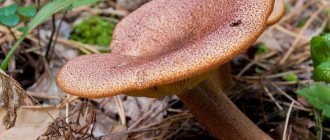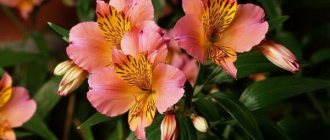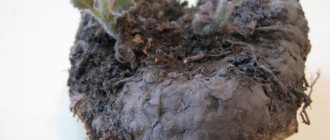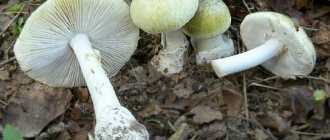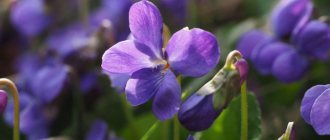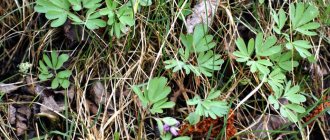Chanterelles
Among the many mushrooms, chanterelles are the most popular. They are edible mushrooms that range in color from pale yellow to orange. They have a rather unusual shape - the center of the cap is concave inward, the edges are curved, uneven.
The leg of the chanterelle is small, strong, and the color is the same as the cap. It should also be noted that the lower part of the fungus grows tightly with the upper one. The mushroom itself is small - the diameter of the cap is from 2 to 10 cm.
Common chanterelle
She is - chanterelle real, chanterelle yellow, cockerel... Highly recognizable and massively collected.
Description
Its fruit bodies are bright yellow or orange-yellow in color. When young, they have convex caps, which, as they mature, bend inward, becoming more and more like a funnel. Diameter - from 2 to 12 cm. In young mushrooms, the edge of the cap is even, smooth, in mature ones, it is wavy, fancifully curved or even some kind of shabby. The leg smoothly passes into the cap, the diameter is from 1 to 3 cm, the height is up to 7 cm.
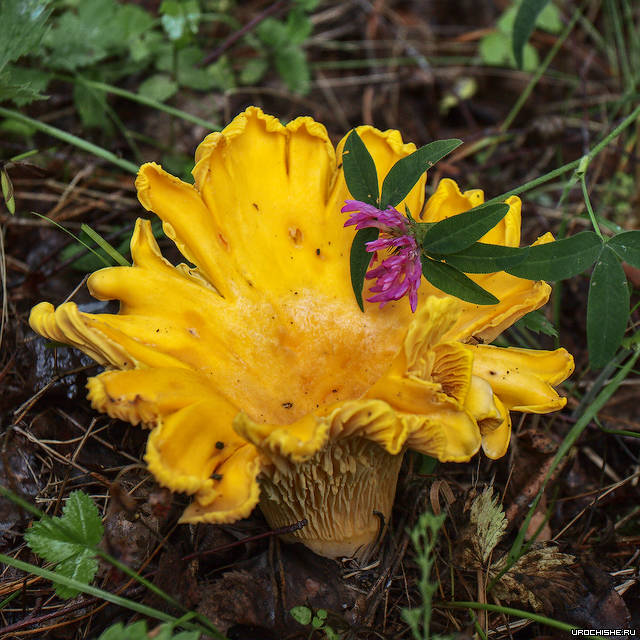
Photo 2. Common chanterelle.
The pulp is dense, fibrous in the stem, light in the center of the fruiting body, rather creamy than yellow, but towards the edges it gradually acquires the color of the skin.
Overripe fruiting bodies begin to decompose and darken from the edges of the cap, while it is clearly visible what can be cut off and thrown away, and what can be put in a basket.
Places of fruiting, collection time
The chanterelle is found everywhere in coniferous and mixed forests, forms mycorrhiza1 with various types of trees, but especially prefers to enter into symbiosis with pine, spruce, oak, beech... Fruiting season - from early June to October, but the most amicable mushrooms usually appear closer to July.
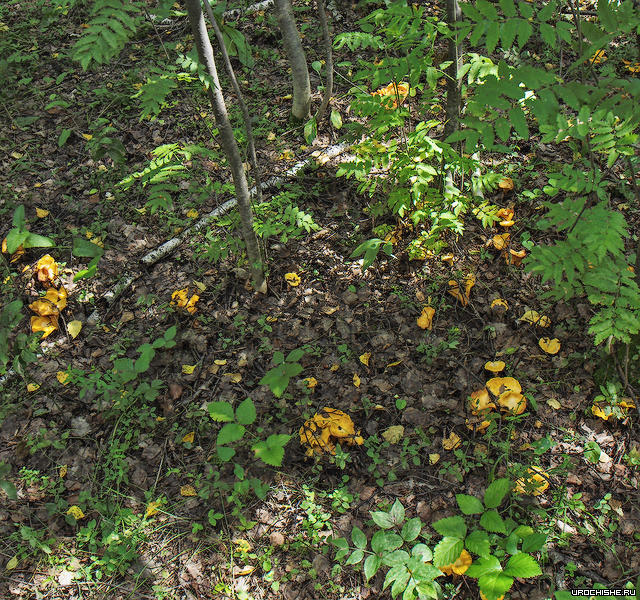

Photo 3. Typical chanterelle place.
You can find them on forest litter, in grass, in moss. As a rule, fruit bodies come out in several pieces - characteristic "witch circles". And quite often there is more than one of the same kind near the found accumulation of mushrooms.
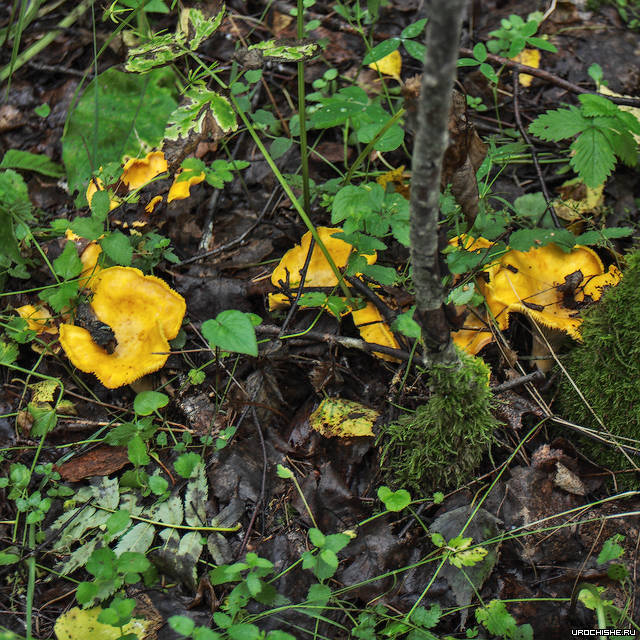

Taste qualities
Chanterelle has a scent referred to as fruity in reference books. However, in my humble opinion - it is very similar to dried chili with some notes of dried apricots. The raw taste is quite pleasant, with a slight sourness (which is leveled by heat treatment).
Best of all, the chanterelle manifests itself in fry - with onions and dill, it can also be stewed in sour cream - with the same onions and a small amount of crushed garlic and other spices. The caviar from it is also excellent. But for soup (in my opinion) it is not very suitable, because it does not boil so well, therefore, it does not give fat, like spongy mushrooms - boletus, redheads and lumps. Although, it also turns out pretty well.
Some gourmets praise pickled chanterelles, but I have not tried them (I generally dislike such preparations - where the original mushroom taste is interrupted by vinegar and spices).
Something about hinomannose
Quinomannose - a pesticide substance contained in chanterelles - the most terrible in its action poison for arthropods and helminths, but absolutely harmless to mammals and humans. That is why these mushrooms almost never contain worms.Wormy chanterelles can only come across only in dry and some abnormal low-mushroom years - when the boogers simply have nothing to eat.
I remember one typical "Ural summer with little snow". The weather was cold throughout June - accordingly, there were never any mushrooms in a month. When it got more or less warmer, chanterelles were the first to crawl out in our forests. It was then that all the pretty hungry flying-crawling small fry pounced on them - starting with a typical mushroom mosquito and ending with wireworms. Interestingly, about a fifth of the collected mushrooms was sharpened with worms in the area of the leg (closer to the bottom - apparently, where the lowest concentration of chinomannose is), or a fat wireworm was sitting in the same place.
Eating mushrooms
Some naturalists believe that nature is completely subject to man. Consequently, even poisonous mushrooms after special processing will become edible. Let's figure out if this is so, whether such dishes are useful and, in general, what can be prepared from chanterelles.
How are chanterelles
Along with good transportability and lack of worminess, chanterelles have one drawback - they cannot be kept warm for a long time. Therefore, the harvested crop must be processed immediately. The process is facilitated by the fact that the mushrooms do not need to be peeled. They are freed from particles of foliage and grass, washed, and then launched into the culinary process.


This variety is suitable for stewing, frying, cooking in soups and baking as a filling for pies and pizzas. In the process of their preparation, there is a very pleasant aroma in the kitchen, which encourages improvisation. As a result, there are many dishes that use chanterelles. They are rarely served in their pure form. Often combined with fried onions, potatoes, "roast". In order for the forest delicacy to reach its readiness, it will take about half an hour.


Is it possible to eat false chanterelles
If expressed in scientific terminology, then these mushrooms are classified as conditionally edible. You should not eat them, especially since during the same period you can collect real tasty and healthy chanterelles.
Some lovers of "quiet hunting" share their experience of preparing false specimens. At the same time, they are pre-soaked for 3 days with a daily two-time change of water. Then they cook with onions for 20 minutes and only after all these manipulations begin cooking.
But all such work and the risk to their own health, as it turns out later, are not at all worth the result. After a long stay in water, the structure of the fungus deteriorates. Moreover, its unpleasant smell and taste does not at all awaken the appetite. Rather, the opposite is true.
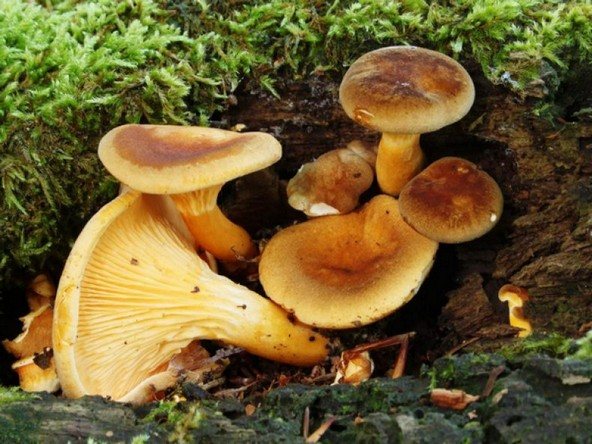

Chanterelle is pale


Photo 5. A pale variety of the common chanterelle.
Colloquial name - chanterelle white... Genetically quite close to the previous fungus, which gives rise to certain disagreements in the circle of mycologists2. A number of scientists consider it a subspecies of the common chanterelle, while some disagree with this and distinguish it as an independent species.
It is very similar to a real chanterelle in everything except color - it is noticeably lighter in it. At the same time, the white chanterelle can be either with a slight yellowish tint, or absolutely colorless - in fact, snow-white. The plates on the underside of the cap are usually cream in color, but sometimes they are also white.
The pale chanterelle grows in almost the same places as the common one, bears fruit at the same time, but mushroom pickers have long noticed that it is more often found exactly where deciduous trees predominate. In general, she is a rather rare guest in baskets.
Why bitterness, how to remove bitterness
Usually chanterelles are bitter if the recommendations for preparation before freezing are not followed. Freshly picked mushrooms sometimes have an unpleasant taste - this happens in dry weather.
To get rid of bitterness, use the following methods:
- soaking in salted water for 12 hours;
- boiling with the addition of citric acid.
Dried chanterelles are soaked in salted water for 5-7 hours, the water is periodically changed. You can also dip it in hot milk and leave for 3 hours.
Amethyst chanterelle
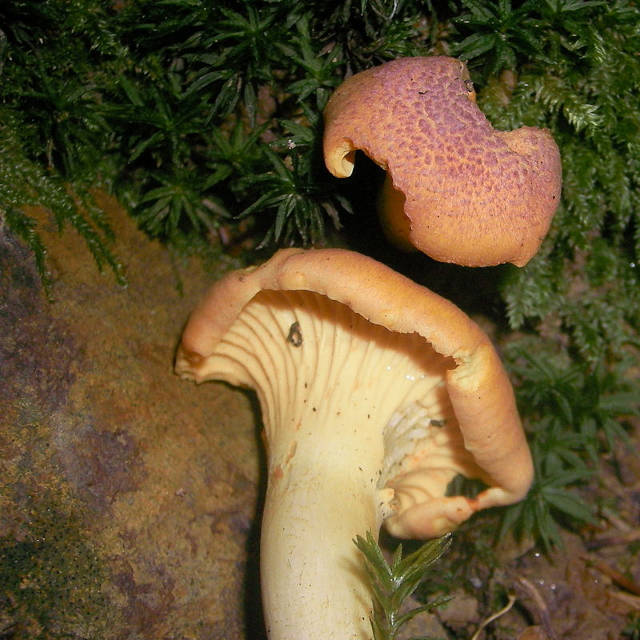

It looks like a common chanterelle (some mycologists also consider it a subspecies), but it looks somewhat "older" - a little paler or darker, somehow harder, and on the upper surface of its cap there is a brownish-purple bloom, which usually thickens towards the center and has a noticeable scaly structure. This is one of the main distinguishing features of this fungus, nevertheless, it can manifest itself in different ways - either distinctly, or barely discernible. Also, some complexity in the definition is introduced by the variety, which is distinguished by a very light color.
Amethyst chanterelle usually forms mycorrhiza with beech, therefore it is found in deciduous forests. Sometimes she was noticed in other places, where she - apparently - entered into symbiosis with other trees - pine, spruce, oak and birch. Bears fruit from June to November - in small clusters, but not at all as massively as the common chanterelle. Found mainly in the south of the country, relatively rare.
Chanterelle velvety
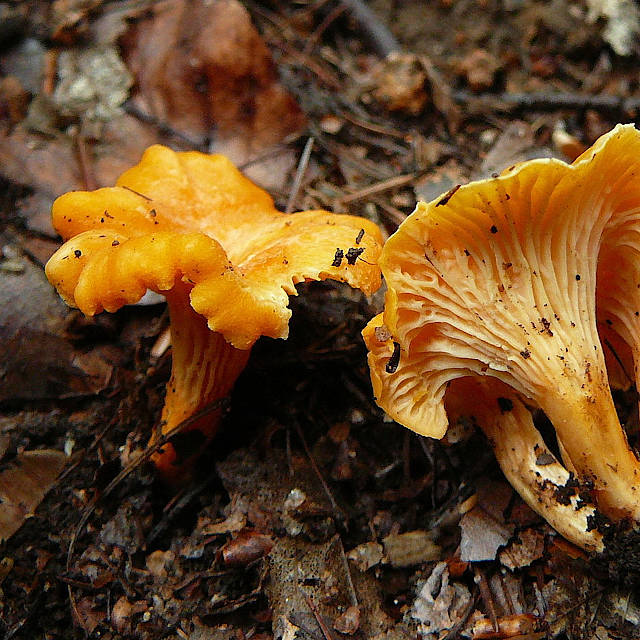

She is - freeza's chanterelle, orange chanterelle... It differs from the ordinary one in the smaller size of the fruit bodies and the color, which is rather not yellow, but bright orange or orange-reddish. At the same time, some fruiting bodies can be evenly colored, while others have a noticeably lighter inner side of the cap and stem.
Apparently, it forms mycorrhiza with several types of trees, but it is found in a rather limited area - in the southeast of Europe, in deciduous forests, on acidic soils. Rare everywhere. Bears fruit from July to October.
The taste is about the same as that of the yellow chanterelle, but they say it tastes slightly bitter.
Cooking use
Chanterelles are good fried, they are also suitable for preservation and stewing, and black mushroom reveals its aroma after drying and is used as a seasoning.
How to fry
- Soak the mushrooms in cold water for 30 minutes.
- Boil in a large saucepan for 15 minutes. When ready, the mushrooms will sink to the bottom. Drain the water.
- Fry onions and garlic in a skillet, then add mushrooms and fry for about 20 minutes more.
- Add dill, parsley and sour cream if desired.
By the way. Chanterelles are very tasty when fried in butter.
Pickling
- Rinse the mushrooms and cut the legs to the very caps.
- Place in a large saucepan and season with salt (50 g per kg).
- Put on fire. When the water boils, add table vinegar (half a glass per 1 kg) and spices (bay leaves, cloves, peppercorns and cinnamon).
- The workpiece then needs to be cooked for about 5 minutes, avoiding a strong boil. Remove foam periodically with a slotted spoon.
- When the chanterelles sink to the bottom of the pan and the marinade turns light, they are placed in a colander and spilled with cold water. The marinade itself will still come in handy.
- Banks are sterilized for half an hour at a temperature of 100 ° C. Mushrooms are laid out in them, poured with broth and rolled up. You can eat in 2 weeks.
Drying
- Rinse the chanterelles and cut in half lengthwise.
- Arrange on a baking sheet, it is good to use baking paper.
- Place in an oven preheated to 50 ℃. The door should be left ajar to allow moisture to escape.
- After an hour, raise the temperature by 10 ° C. Check the mushrooms periodically and turn them over so they don't burn. Drying will take about 3 hours.
Chanterelles can also be stewed, used in salads and hot dishes, pasta and risotto. But first, the mushrooms should be boiled.
Tubular chanterelle
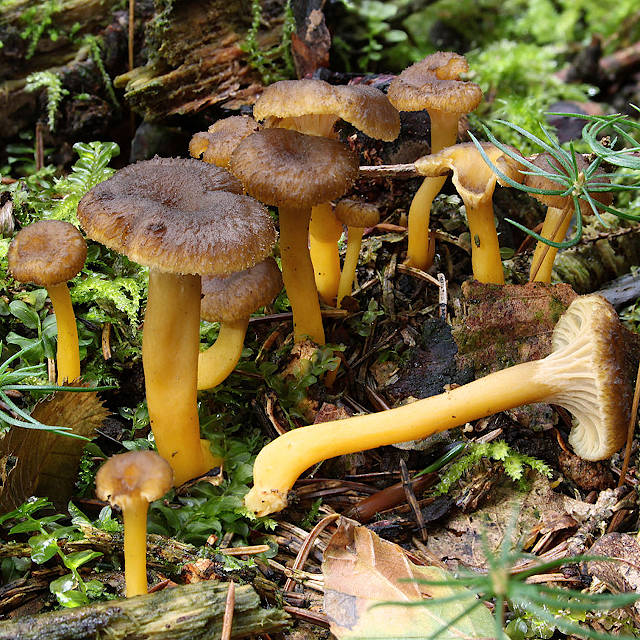

This mushroom got its name for a reason - its leg is hollow inside, and in mature fruiting bodies, a small hole opens in the center of the cap.
The color is very different from other chanterelles. Above, the cap is brownish or gray-yellow, sometimes it has a red tint. Most often with noticeable scales. Below - wrinkled from the plates, much lighter (up to almost white). The leg is chrome-yellow, turning pale with age. Dimensions - less than that of an ordinary chanterelle: up to 6 cm in diameter and up to 8 cm in height.
The tubular chanterelle clearly prefers conifers to deciduous trees, therefore it is found in the corresponding forests - pine forests, spruce forests or mixed... Also, according to some reports, it is not only able to form mycorrhiza, but also feed on wood residues - like a typical saprophyte3. Bears fruit the whole autumn season - before the first bit of frost, at the peak of fruiting, mushrooms appear in large numbers, in friendly clusters.
In terms of taste, it is not inferior to an ordinary chanterelle, however, it has a noticeably tougher pulp, which confuses some gourmets. To neutralize this disadvantage, the mushroom has to be heat treated longer.
Chanterelle yellowing


Genetically close to the previous chanterelle, in shape it is very similar. One of the distinguishing features is color. The entire underside of the cap and stem are uniformly colored, ranging from white to bright orange. Also, the edges of the cap of a yellowing chanterelle are often fringed.
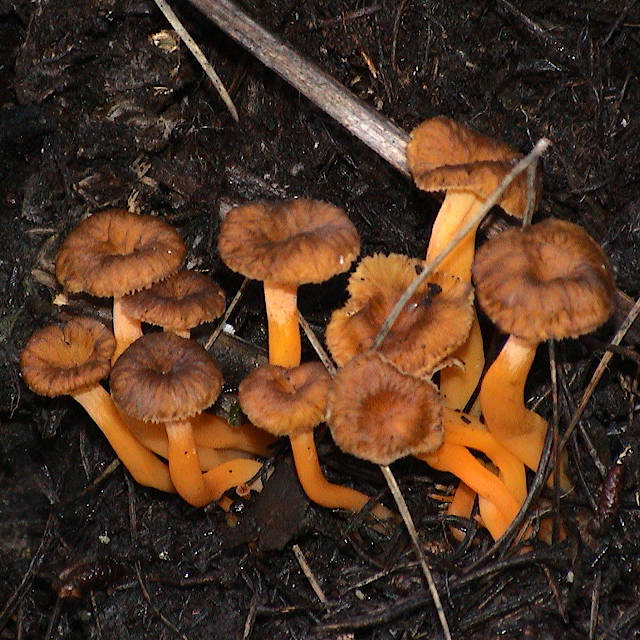

Photo 10. Young fruiting bodies of a yellowing chanterelle.
It grows in damp coniferous forests - in moss, on old wood. Bears fruit from summer to early autumn.
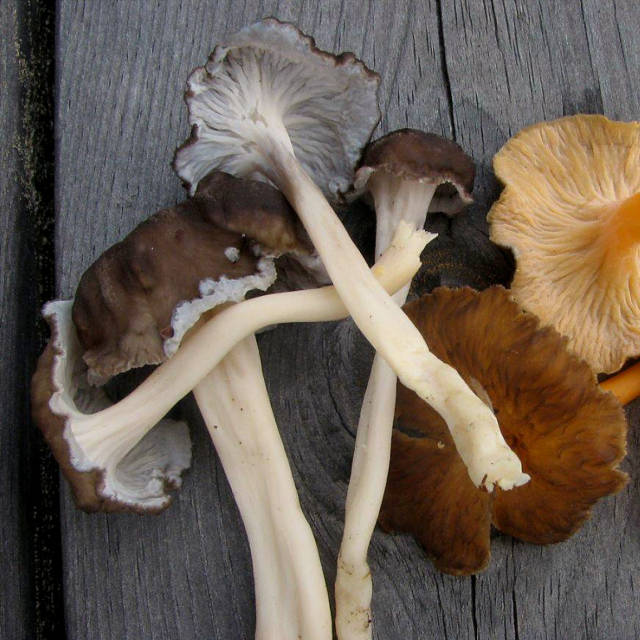

Photo 11. Light color variation.
In terms of taste, it is considered a good mushroom. True, it has no special taste and smell.
Chanterelle gray
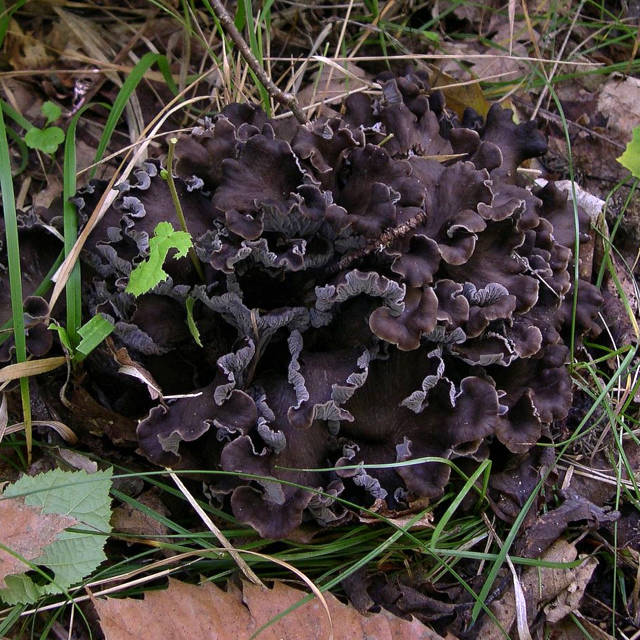

The shape of the fruiting body is similar to the common chanterelle, but usually smaller, with a decent depression in the center of the cap, turning into a stem (the mushroom is more like a funnel). The color is not at all the same: the hat on top is dark gray or dark brown, but noticeably lighter - ash or light blue - from the lower surface, which is also covered with wrinkle folds (I advise you to pay attention to this sign, it will still be useful to us ). The leg is darker than the bottom of the cap.
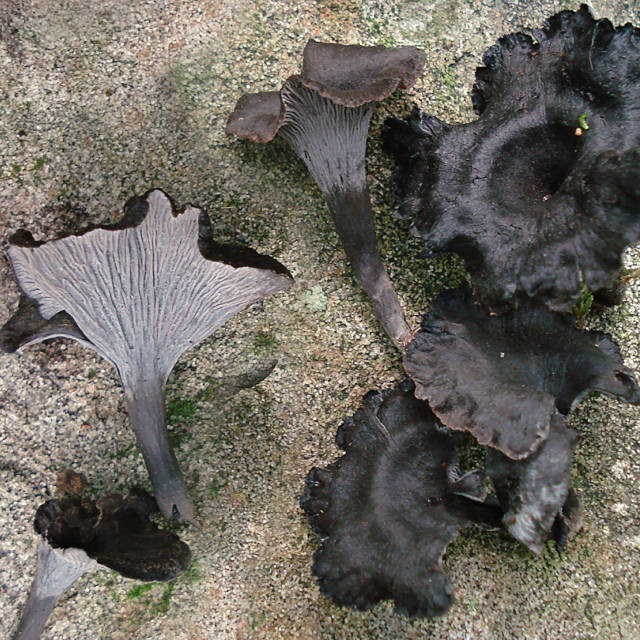

Photo 14. The underside of the cap of the gray chanterelle.
Distributed in the European part of the continent - in the temperate zone and to the south. Forms mycorrhiza with oak and spruce, respectively, you can find it in those forests where these trees grow. Bears fruit from August to October... In some places, the gray chanterelle is found quite massively, but in some places it is rare.
Its taste - according to those who have tried this mushroom - is very good - with a pronounced fruity aroma and spicy-woody taste. True, a number of authors consider it tasteless.
The gray chanterelle is listed in the Red Book of the Republic of Belarus.
Black chanterelle (horn-shaped funnel)


She is - funnel pot gray (listed in the chanterelle family, but belongs to a slightly different genus - funnels). This mushroom should be given special attention, because in its taste it surpasses real chanterelles, and in some developed countries it is considered a delicacy - there it is placed on a par with truffles and morels.
The shape of the horn-shaped funnel resembles a pipe rather than a funnel - quite deep, right up to the mycelium, with the edges turned outward, dark brown, almost black in color inside and gray-gray outside. Size - 3-8 cm in diameter, 5-12 cm in height. In young fruiting bodies, blackness is most pronounced.
It is very similar to the gray chanterelle, but it has a very noticeable distinctive feature: on the underside of its cap there are no pronounced folds resembling "standard" mushroom plates.
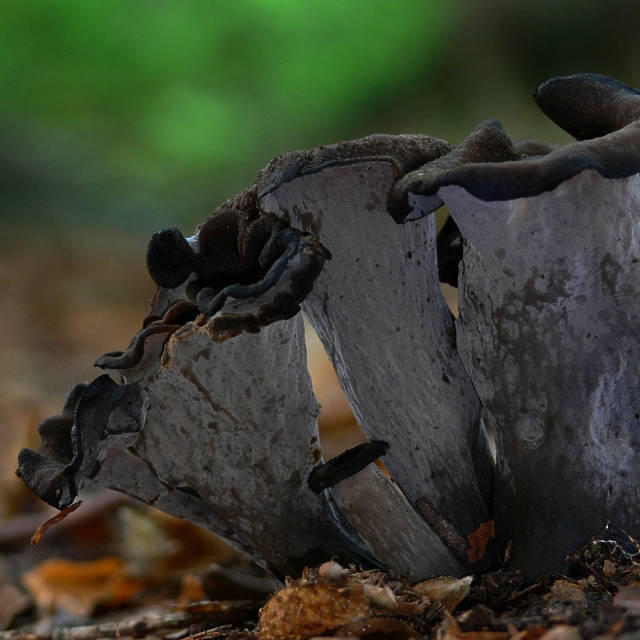

The horn-shaped funnel is well disguised as fallen leaves - it is not so easy to find it.
It is widely distributed in the temperate zone and further south, from Europe to the Far East. Grows in those forests where there is oak, beech, hazel and spruce... Fruiting from July to October, most massively - from mid-August to mid-September, usually in friendly clusters. In southern latitudes - with warm, snowless winters, it can be found in forests up to November.
Interestingly, there are two points of view about the nature of the nutrition of this mushroom. In the post-Soviet space, the horn-shaped funnel is recognized as a mycorrhizal forming agent, while Western mycologists consider it a saprophyte. It is likely that depending on the area - this mushroom can eat in both ways.
Growing at home
It is possible to grow chanterelles on your site, provided that there are trees with which they form a symbiotic relationship. These trees include oak, spruce, fir and beech.
The choice of planting material
As a seed, the mycelium or fruiting bodies of ripe mushrooms are used. Moreover, if a spruce grows on the site, then the seedlings should be collected under the spruce, otherwise the chanterelle will not take root.
Technology
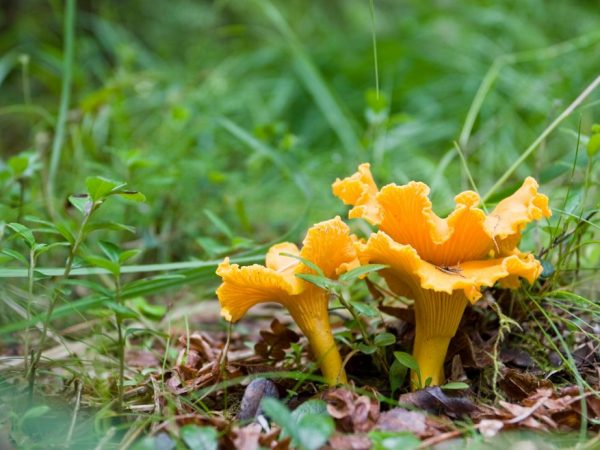

Chanterelles can be grown on the site
When breeding chanterelles from the mycelium, proceed as follows:
- a tree is found in the forest with mushrooms growing, the presence of fruit bodies is optional (you must know this for sure, so designate a collection point for your own purposes);
- a small lump of earth is dug up next to the roots; thin filaments of mycelium should be noticeable in the soil;
- the collected mycelium with soil is placed in a bag and left in a cool room for 3 months, this is necessary to destroy harmful organisms (it is best to collect in the fall, in order to start planting at the beginning of spring;
The bag should not be tied tightly - fresh air is needed. It is not terrible if the earth dries up, but frosts should not be allowed.
2 days before planting, you need to water the intended planting site well, and on the day of sowing, disinfect the soil with a strong infusion of oak bark.
At the end, the prepared mycelium is placed in small pits and sprinkled with earth.
When breeding from fruit bodies, a spore infusion is prepared:
- choose several overripe chanterelles and cut off the caps;
- they are placed in a container with water, preferably rainwater;
- add 50 g of sugar and leave for a day;
- then the caps need to be kneaded, and the solution is filtered through cheesecloth.
For planting, choose a darkened area under the tree, watered abundantly. Next, they dig out shallow pits (up to 15 cm). They are watered with a decoction of oak bark and left for a couple of hours for disinfection. Next, the ground is irrigated with the prepared infusion, and the mushroom caps remaining in the gauze are laid out near the roots of the tree. The sowing is covered with earth and watered.
With a favorable outcome in both cases, the chanterelles will begin to bear fruit in a year.
Chanterelle wavy (pseudo-funnel winding)
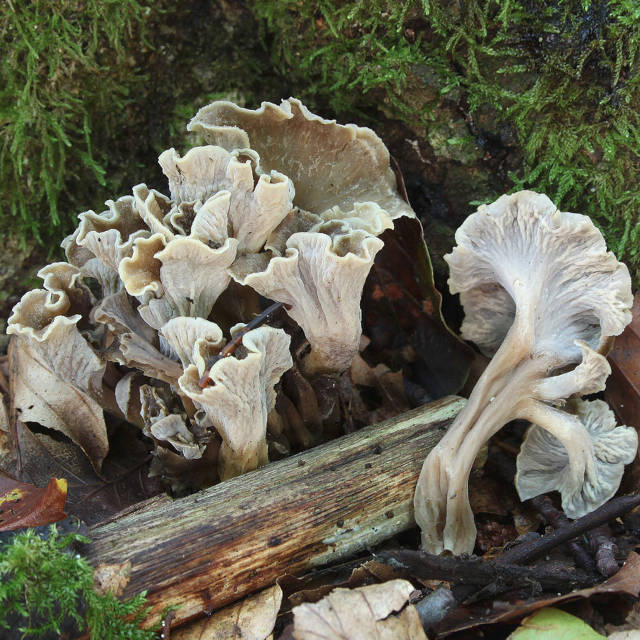

A mushroom with a completely unsightly taste, and in some sources it is considered completely inedible.
Its small fruiting bodies - from 1 cm to 5 cm in diameter, and up to 5 cm in height - light brown or gray - appear in damp, or even swampy mixed and deciduous forests - from July to October.
First aid for poisoning
The first signs of poisoning come two hours after eating. They manifest themselves in severe abdominal pain, nausea, vomiting, diarrhea. A person's limbs begin to grow cold, the pulse rises. In severe cases, hallucinations and delusional states appear.
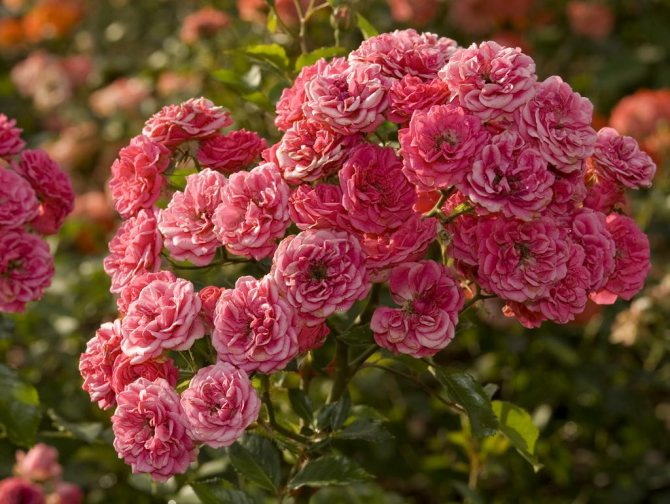

The appearance of any symptom should alert you. The patient needs to be put to bed, to give copious drinks before the arrival of an ambulance. Of the drugs, the use of activated carbon is allowed.
When collecting mushrooms, you need to be careful, as there is a risk of collecting poisonous species. At the slightest doubt about the edibility, it is better not to cut the mushroom.It is advisable to go to the forest with an experienced person who knows all the varieties of mushrooms.
North American chanterelles
Perhaps this article will be incomplete if at least briefly not to mention those types of edible chanterelles that are not found in our country, but grow "overseas" - in North America. They usually form mycorrhiza with hardwood trees, for example - with oak trees, respectively, and are found in the places where they grow.
Cinnabar red chanterelle
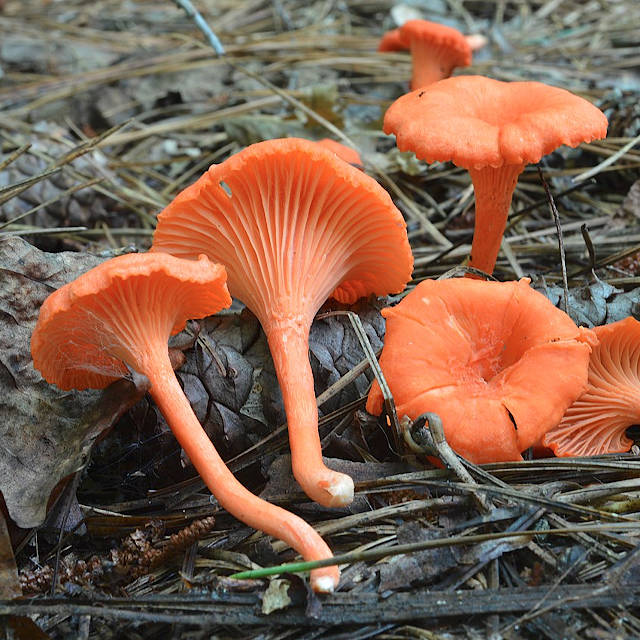

The owner of an unusual red-orange color, which is most pronounced in young mushrooms. True, with age, it fades slightly, although the mushroom does not become less beautiful from this.
The size of the fruit bodies is small - the cap is up to 4 cm in diameter, the leg is about the same length, up to a centimeter thick.
Distributed in the east of the continent. Fruiting in summer and autumn, it is considered quite edible.
Faceted chanterelle
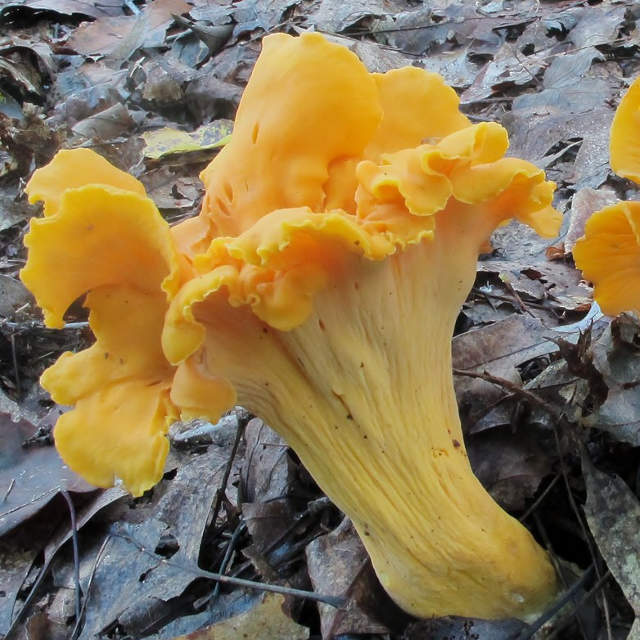

Almost a complete analogue of our yellow chanterelle - it is very similar to it, but instead of plates it has wrinkles. In terms of taste, it also corresponds to it. Distributed throughout North America and is fairly common in many forests and parks. Fruiting in summer and autumn.
Fragrant chanterelle


The color is similar to the common chanterelle, but the shape clearly resembles funnel mushrooms. Scientifically, it is called so - odorous funnel.
Found in the eastern United States and Mexico.
Small chanterelle
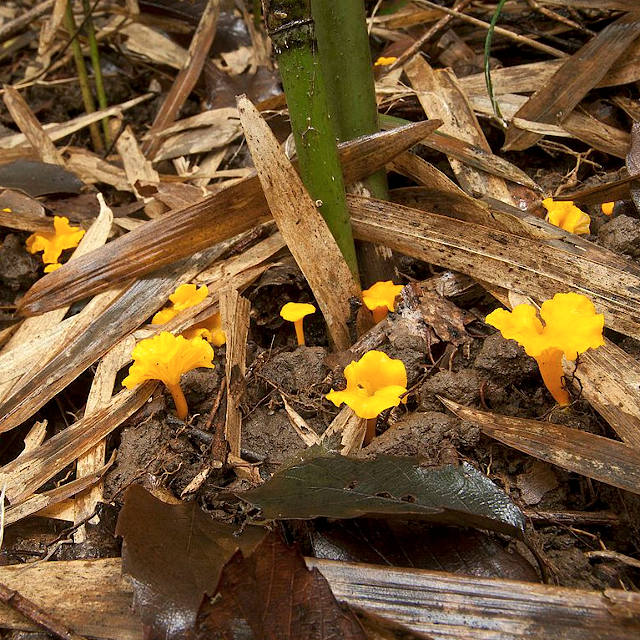

This is something like a miniature copy of an ordinary chanterelle. The size, of course, is small - the hat is no more than 3 cm in diameter on a thin leg, but nevertheless, it is quite suitable for food. Distributed in the east of the continent.
Chanterelle whitish


It also looks like an ordinary chanterelle, but has a pronounced light - white or cream color, also its pulp without a "fruity" smell. It is found in coniferous forests - unlike previous mushrooms, it forms mycorrhiza with pine, Douglas fir and Menzis strawberry tree.
Beneficial features
Chitinmannose, ergosterol, trametonolinic acid and other polysaccharides contained in chanterelles are a good prevention of the appearance of worms. Ergosterol helps cleanse and restore liver function. This leads to the use of various extracts from this type of mushroom in the treatment of hepatitis C and other liver diseases.
Tubular chanterelle is actively used in eastern countries for the manufacture of natural biologically active food supplements designed to fight parasites in the body. These drugs are most often produced in capsule form.
False chanterelles
Now is the time to mention those mushrooms that make no sense to collect - either because of their frankly low taste, or because of their toxicity.
False fox (orange talker)
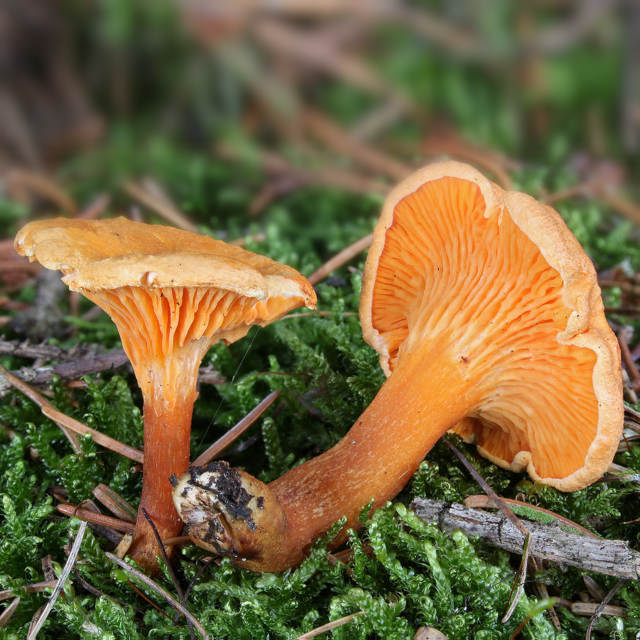

By its color and shape it is more reminiscent of a young chanterelle, but it has a typical "talker" appearance - a rounded hat with an even edge turned inward. There is a clear transition between the cap and the leg, and that one is noticeably darker, brighter and thinner than that of real chanterelles. And the hat itself is velvety, in contrast to the smooth one in chanterelles. It is not difficult to distinguish it from edible mushrooms.
Distributed throughout Europe and Asia, grows in conifers or mixed forests, bears fruit mid-August to mid-September.
Opinions were divided about the edibility of the false chanterelle. Previously, it was considered a poisonous mushroom, nowadays it is edible of low quality or slightly poisonous.
Humpbacked chanterelle (cantarellula tubercle)


Despite the name, this is not a chanterelle, but a ryadovka. It has a characteristic funnel-shaped fruiting body of gray-gray color (there is a small chance of confusing it with gray chanterelles). It is considered a conditionally edible mushroom, but most likely has no nutritional value - due to its small size and completely unsightly taste.
Occurs in conifers and mixed forests, in damp places, in moss.Bears fruit from late summer to early autumn.
Omphalot olive
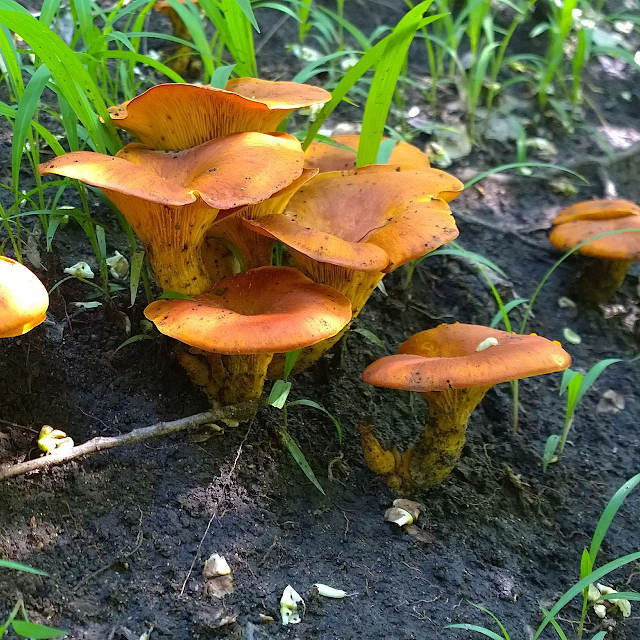

A poisonous mushroom that looks like a common chanterelle. It grows in the Mediterranean, and was also found in the Crimea. Contains a dangerous alkaloid muscarine - the same one that is in the red fly agaric. Usually omphalot is easy to distinguish from foxes - it is somewhat thinner, darker, rather brownish-orange than yellow, also the edges of its cap are even, bent downward, and the cap itself is smooth. And this mushroom grows like a honeydew - on wood residues. However, at times its fruiting bodies grow light and uneven - then they imitate a chanterelle very well, and the only sign by which they can be identified is an unpleasant smell of pulp.
Quite a rare mushroom. Fruiting on stumps and decaying wood of oak, hornbeam, olive tree. Season - from September to October.

